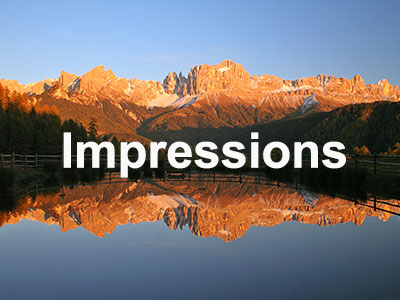Excursion tips
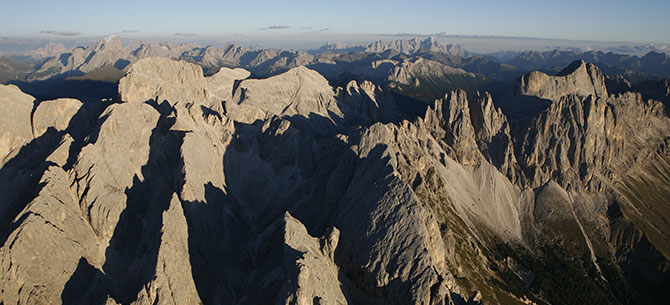
Dolomites - Roundtrip
The Dolomites are situated in the Southern Alpes.
Since June 26th 2009 parts of the Dolomites have become UNESCO Natural World Heritage.
On this tour you’ll enjoy an intimate experience of one of the most beautiful mountain ranges in the world. Through the romantic Tiers valley along the Rosengarten and the Passo Carezza the tour leads through the Val di Fassa to Canazei and from there to the Lago Fedaia located at the mountain Marmolada. You’ll enjoy the spectacular view at the “Sellajoch” with the beautiful surrounding mountains. From there the road leads down to Selva Gardena and through the famous Val Gardena up to Kastelruth, Seis, Völs and Castle Prösels back to Tiers.
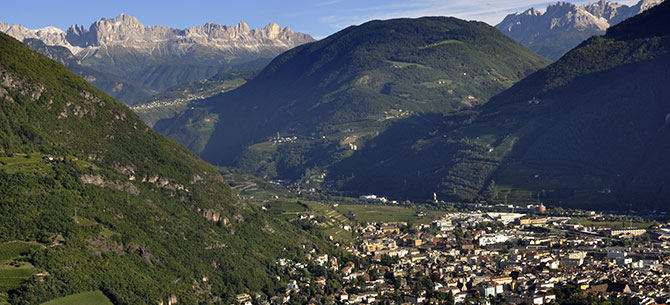
Bolzano
Bolzano, the capital of South Tyrol, is only a 30 minute drive away from our hotel.
Boasting a number of some 100,000 inhabitants and located almost in the centre of the region, the provincial chief city is located between 232 and 1,616 m asl. In fact, already millenniums ago the valley basin of Bolzano has been settled, the first settlement in this area was called “Bauzaunum”, probably named after the first settler “Bauzus”. In the 12th and 13th century people started building the city, the Mediaeval town that developed remained unchanged up to the 19th century. This was when Bolzano started becoming a tourism stronghold. Above all the quarter of Gries was famous on a worldwide scale as climatic spa.
Today Bolzano comprises five quarters, as well as the little mountain village of Colle di Villa. Particularly worth seeing is the historic town with its arcades. Moreover Bolzano is famous for its varied cultural attractions, such as the Iceman in the provincial Archaeological Museum or the specialized fairs regarding various topics taking place in the Bolzano fair centre. A total of seven museums as well as four castles and mansions can be experienced in the chief city. In the arcades, however, still today you can enjoy authentic the atmosphere of the “little large” city.
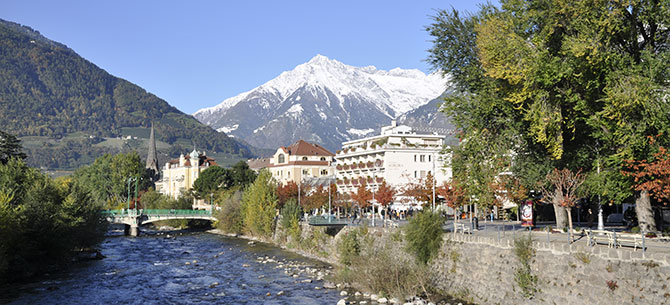
Merano
in 45 minutes one can reach Merano.
Merano or Meran is a town and comune in South Tyrol, Italy. Generally best known for its spa resorts, it is located within a basin, surrounded by mountains standing up to 3,335 m (11,000 ft), at the entrance to the Passeier Valley, the Vinschgau and the Ulten Valley. In the past the town has been a popular place of residence for several scientists, literary people, and artists, including Franz Kafka, Ezra Pound and Paul Lazarsfeld, who appreciated its mild climate.
The area has been inhabited since the 3rd millennium BC, as shown by the presence of menhirs and other findings. The story of the city proper began in 15 BC when the Romans occupied the Adige valley founding a road station, Statio Maiensis.
The settlement was first mentioned in an 857 deed as Mairania. The Counts at Castle Tyrol elevated Meran to the status of a city during the 13th century and made it the capital of their County of Tyrol. After the county had been handed over to the Habsburg dynasty in 1363 upon the abdication of Margaret, Countess of Tyrol, in 1420 Frederick IV, Duke of Austria moved the Tyrolean court to Innsbruck. Though Meran remained the official capital until 1848, it subsequently lost its predominant position and almost all its importance as an economic hub across the roads connecting Italy and Germany. The important mint was also moved to Hall in 1477.
The Tyrolean Rebellion of 1809 against the French occupation drew attention again to Meran. In that year, on the Küchelberg above the city, a peasants' army eked out a victory against the united French and Bavarian forces, before their revolt was finally crushed. After World War I, under the Treaty of Saint-Germain-en-Laye Meran became part of the Kingdom of Italy with the rest of the southern part of the former Cisleithanian crown land of Tyrol.
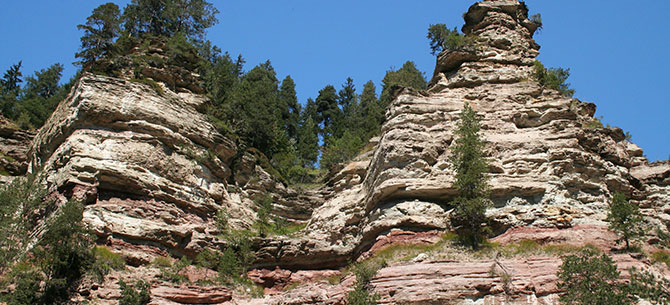
Geoparc Bletterbach Canyon
The Bletterbach Canyon is unique in Europe!
The Bletterbach Canyon is unique in the whole of Europe! The canyon gives an insight into the mountains and their development over millions of years! The Canyon is the result of weathering and degradation. Since the Ice Age about 15,000 years ago, the water of the Bletterbach stream has cut a gorge measuring about 8 kilometres in length and up to 400 metres in depth into the mountainside. Layer after layer was uncovered. Now you can skim through these layers like in a book. Unlike similar cases in other areas of the Alps, the layers in the Bletterbach Canyon are undamaged. The composition of the rocks provides information on the development, the climate, and the environmental conditions of 250 million years ago.
Highlights:
Traces of dinosaurs in the layers of the Gardena sandstone
Fossils in the sea deposits like sea shells, snails, and cephalopods provide evidence of life in warm, tropical seas
Well preserved imprints of plant parts and numerous gnaw marks tell us about the plants and the activities on the ground from this period.
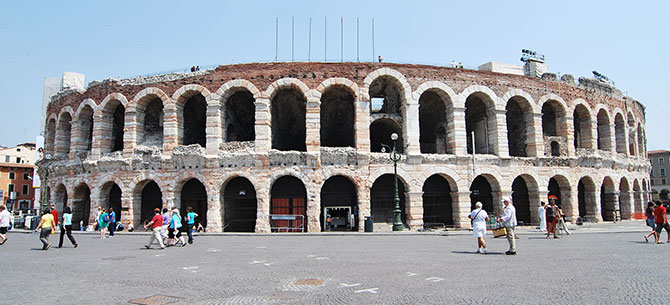
Verona
Verona is a city in Veneto in northern Italy.
Verona is a city in Veneto, northern Italy, home to approx. 265,000 inhabitants and one of the seven provincial capitals of the region. It is the second most populous municipality of the region and the third of North-East Italy. The metro area of Verona has an area of 1,426 km2 (550.58 sq mi) and has a population of 714,274 inhabitants. It is one of the main tourist destinations in northern Italy, thanks to its artistic heritage, several annual fairs, shows, and operas, such as the lyrical season in the Arena, the ancient amphitheatre built by the Romans.
History
The precise details of Verona's early history remain a mystery. The origin of the name Verona is also unknown. One theory is it was a city of the Euganei, who were obliged to cede it to the Cenomani (550 BC). With the conquest of the Vaecame Roman (about 300 BC). Verona became a Roman colonia in 89 BC, and then a municipium in 49 BC; Verona had the franchise in 59.
The city derived importance from being at the intersection of several roads. Stilicho defeated Alaric and his Visigoths here in 403. But with the taking of Verona (489 AD) the Gothic domination of Italy began; Theodoric built his palace there, and in Germanic legend the name of Verona is linked with his. This city remained in the power of the Goths all through the Gothic War (535–552), with the exception of a single day in 541, when the Armenian officer Artabazes effected an entrance. Dissensions which arose among the Byzantine generals in regard to booty enabled the Goths to regain possession. In 552 Valerian vainly endeavoured to gain an entrance, and only the complete overthrow of the Goths brought about its surrender.
In 569 it was taken by Alboin, King of the Lombards, in whose kingdom it was, in a sense, the second city in importance. There Alboin himself was killed by his own wife in 572. The dukes of Treviso often resided there. At Verona Adalgisus, son of Desiderius, in 774 made his last desperate resistance to Charlemagne, who had destroyed the Lombard kingdom. Verona was then the ordinary residence of the kings of Italy, the government of the city becoming hereditary in the family of Count Milo, progenitor of the counts of San Bonifacio. From 880 to 951 the two Berengarii resided there. Otto I ceded to Verona the marquisate dependent on the Duchy of Bavaria.
The splendour of the city in those days, dominated by its forty-eight towers, is described in a Latin ode of which we shall speak later on. The increasing wealth of the burgher families eclipsed the power of the counts, and in 1100 Verona organised itself as a commune. The San Bonifacio could at most hold the office of podestà of the city now and then. Verona, at first undecided, was forced by Vicenza to join the Lombard League. This, however, gave rise to the factions of Guelphs and Ghibellines in Verona. When Ezzelino IV was elected podestà, in 1226, he was able to convert the office into a permanent lordship, and in 1257 he caused the slaughter of 11,000 Paduans on the plain of Verona (Campi di Verona). Upon his death the Great Council elected as podestà Mastino della Scala, and he converted the "signoria" into a family possession, though leaving the burghers a share in the government. Failing to be re-elected podestà in 1262, he effected a coup d'état, and was acclaimed capitano del popolo, with the command of the communal troops. It was not without long internal discord that he succeeded in establishing this new office, to which was attached the function of confirming the podestà. In 1272 Mastino was killed by the faction of the nobles.
The reign of his son Alberto as capitano (1277–1302) was one incessant war against the counts of San Bonifacio, who were aided by the House of Este. Of his sons, Bartolomeo, Alboino and Cangrande I, only the last shared the government (1308); he was great as warrior, prince, and patron of the arts; he protected Dante, Petrarch, and Giotto. By war or treaty he brought under his control the cities of Padua (1328), Treviso (1308) and Vicenza.
Alberto was succeeded by Mastino II (1329–1351) and Alberto, sons of Alboino. Mastino continued his uncle's policy, conquering Brescia in 1332 and carrying his power beyond the Po. He purchased Parma (1335) and Lucca (1339). After the King of France, he was the richest prince of his time. But a powerful league was formed against him in 1337 – Florence, Venice, the Visconti, the Este, and the Gonzaga. After a three years war, the Scaliger dominions were reduced to Verona and Vicenza (Mastino's daughter Regina-Beatrice della Scala married to Barnabò Visconti). Mastino's son Cangrande II (1351–1359) was a cruel, dissolute, and suspicious tyrant; not trusting his own subjects, he surrounded himself with Brandenburg mercenaries. He was killed by his brother Cansignorio (1359–1375), who beautified the city with palaces, provided it with aqueducts and bridges, and founded the state treasury. He also killed his other brother, Paolo Alboino. Fratricide seems to have become a family custom, for Antonio (1375–87), Cansignorio's natural brother, slew his brother Bartolomeo, thereby arousing the indignation of the people, who deserted him when Gian Galeazzo Visconti of Milan made war on him. Having exhausted all his resources, he fled from Verona at midnight (19 October 1387), thus putting an end to the Scaliger domination, which, however, survived in its monuments.
The year 1387 is also the year of the famous Battle of Castagnaro, between Giovanni Ordelaffi, for Verona, and John Hawkwood, for Padua, who was the winner.
Antonio's son Canfrancesco in vain attempted to recover Verona (1390).
Guglielmo (1404), natural son of Cangrande II, was more fortunate; with the support of the people, he drove out the Milanese, but he died ten days after, and Verona then submitted to Venice (1405). The last representatives of the Scaligeri lived at the imperial court and repeatedly attempted to recover Verona by the aid of popular risings.
From 1508 to 1517 the city was in the power of the Emperor Maximilian I. There were numerous outbreaks of the plague, and in 1629–33 Italy was struck by its worst outbreak in modern times. In Verona an estimated 33,000 people (of a total of 54,000) died in 1630–1631.
Verona was occupied by Napoleon in 1797, but on Easter Monday the populace rose and drove out the French. It was then that Napoleon made an end of the Venetian Republic. Verona became Austrian territory when Napoleon signed the Treaty of Campo Formio in October, 1797. The Austrians took control of the city on January 18, 1798. It was taken from Austria by the Treaty of Pressburg in 1805 and became part of Napoleon's Kingdom of Italy, but was returned to Austria following Napoleon's defeat in 1814, when it became part of the Austrian-held Kingdom of Lombardy-Venetia. In 1866, following the Six Weeks War, Verona, along with the rest of Venetia, became part of Italy.
In 1866, on the anniversary of the defeat of Königrätz, the Austrians evacuated Verona, their strongest fortress in Venetia, which thus became Italian.
The advent of fascism added another dark chapter to the annals of Verona. As throughout Italy, the Jewish population was hit by the anti-Semitic laws (1938), and after the invasion by Nazi Germany in 1943, deportations to Nazi concentration camps. An Austrian Fort (now a church, the Santuario della Madonna di Lourdes), was used to incarcerate and torture allied troops, Jews and anti-fascist suspects especially after 1943, when Verona became part of the Repubblica di Salò or "Social Republic".
As in Austrian times, Verona became of great strategic importance to the regime. Galeazzo Ciano, Benito Mussolini's son in law was accused of plotting against the republic during a mock trial staged by the Nazi and fascist hierarchy in Castelvecchio. Ciano was executed on the banks of the Adige with many other officers on what is today Via Colombo. This marked another turning point in the escalation of violence that would only end with the final liberation by allied troops and partisans in 1945.
After World War II, as Italy entered into NATO, Verona acquired once again its strategic importance, due to its closeness to the iron curtain. The city became the seat of SETAF (South European Allied Terrestrial Forces) and had during the whole duration of the Cold War period a strong military presence, especially American, which is decreasing only in these recent years. Now Verona is an important and dynamic city, very active in terms of economy, and also a very important tourist attraction because of its history, where the Roman past lives side by side with the Middle Age Verona, which in some senses brings about its architectural and artistic motifs.
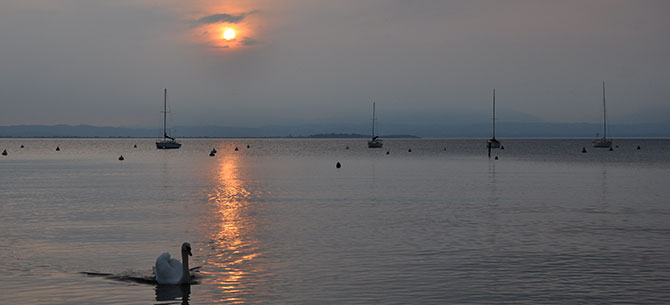
Lake Garda
Lake Garda is the largest lake in Italy. It is located in Northern Italy, about half-way between Brescia and Verona, and between Venice and Milan. Glaciers formed this alpine region at the end of the last ice age. The lake and its shoreline are divided between the provinces of Verona (to the southeast), Brescia (southwest), and Trentino (north). Being easily accessible from the north via the Brenner Pass, the lake is a major tourist destination, including a number of exclusive hotels and resorts along its shore.
The northern part of the lake is narrower, surrounded by mountains, the majority of which belong to the Gruppo del Baldo. The shape is typical of a moraine valley, probably having been formed under the action of a Paleolithic glacier. Although traces of the glacier's actions are evident today, in more recent years it has been hypothesized that the glacier occupied a previously existing depression, created by stream erosion 5 to 6 million years ago.
The lake has numerous small islands and five main ones, the largest being Isola del Garda. Nearby to the south is Isola San Biagio, also known as the Isola dei Conigli ("Island of the Rabbits"). Both are offshore of San Felice del Benaco, on the west side. The three other main islands are Isola dell'Olivo, Isola di Sogno, and Isola di Trimelone, all further north near the east side. The main tributary is the Sarca River, while the only emissary is the Mincio River.
The ancient fortified town of Sirmione, located on the south of the lake, is one particularly popular destination, home to the Virgilio & Catullo Spa Complexes, as well as numerous restaurants, bars, hotels, fashion stores and a market. The picturesque Scaliger castle dates from the 13th century. The Roman poet Catullus had a villa here, and visitors can see a ruined Roman spa named the Grotte di Catullo (Grotto of Catullus) although there is no evidence linking him to this particular building. The sulfur springs at the tip of the peninsula have a reputation for the healing of catarrhal conditions, particularly those involving the ear. Nearby, there is Gardaland, one of the most famous theme parks in Italy.



